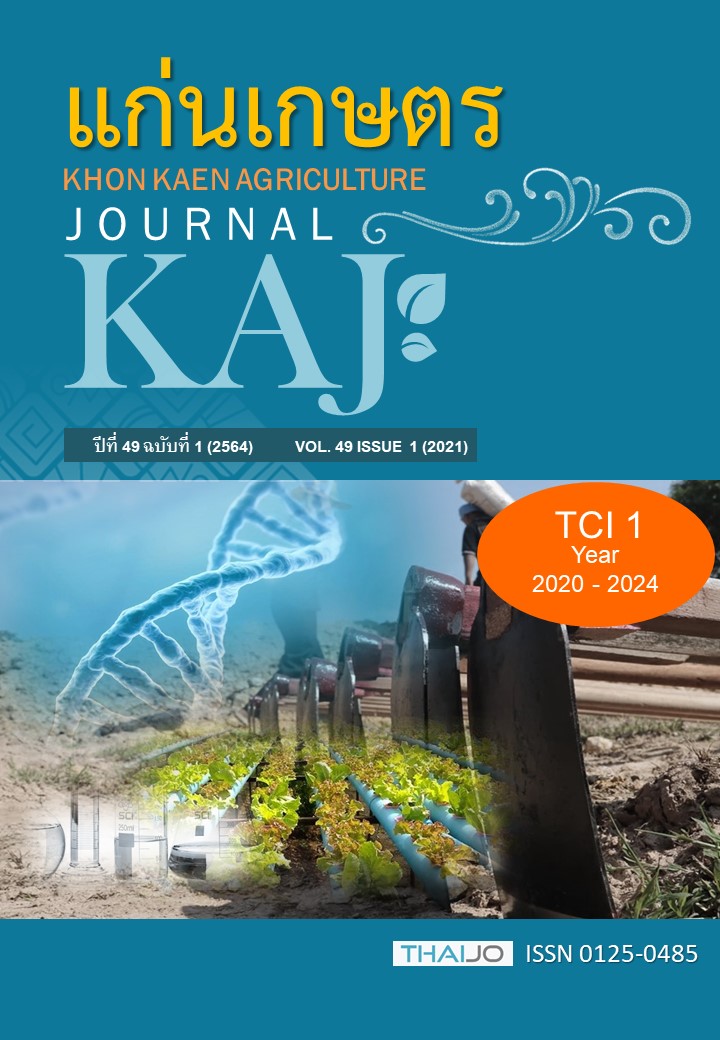Effects of carbon and nitrogen sources on fruiting body formation and cordycepin production of Cordyceps militaris (L.) Link
Main Article Content
บทคัดย่อ
Cordyceps militaris (L.) Link is an entomopathogenic fungus. It has been accumulated the bioactive compounds including cordycepin and adenosine that reduced blood cholesterol and provide improved anti-cancer, and immune support. The objectives of this study were to establish an effective medium for fruiting body formation of C. militaris and to evaluate cordycepin and adenosine contents. Each medium contained different types of carbon sources (sucrose, glucose) and nitrogen sources (yeast extract, peptone). For the BH strain, the highest length of fruiting bodies (4.61±0.45 cm), fresh weight (35.37 ± 1.16 g/bottle) dry weight (11.88±0.29 g/bottle) and cordycepin contents (6.92±0.09 mg/g) were observed on T6 medium supplemented with 20 g/l sucrose and 20 g/l yeast extract and the highest adenosine contents (0.10±0.02 mg/g) were found in T2 medium supplemented with 10 g/l sucrose and 10 g/l yeast extract. For the DA strain, the highest length of fruiting bodies (4.26±0.08 cm), fresh weight (31.89±0.25 g/bottle) dry weight (10.02 ± 0.15 g) and cordycepin contents (3.95±0.05 mg/g) were obtained from T6 medium supplemented with 20 g/l sucrose and 20 g/l yeast extract and the highest adenosine contents (0.72±0.00 mg/g) was achieved on T5 medium supplemented with 20 g/l glucose and 20 g/l peptone.
Article Details

อนุญาตภายใต้เงื่อนไข Creative Commons Attribution-NonCommercial-NoDerivatives 4.0 International License.
เอกสารอ้างอิง
Dang, H., C. Wang, and H. Lay. 2018. Effect of nutrition, vitamin, grains, and temperature on the mycelium growth and antioxidant capacity of Cordyceps militaris (strains AG-1 and PSJ-1). Journal of Radiation Research. 11: 130-138.
Das, S., M. Masuda, A. Sakurai, and M. Sakakibara. 2010. Review Medicinal uses of the mushroom Cordyceps militaris: Current state and prospects. Fitoterapia. 81:961-968.
Dworecka-Kaszak, B. 2014. Cordyceps fungi as natural killers, new hopes for medicine and biological control factors. Annals of Parasitology. 60: 151-158.
Huang, L., Q. Li., Y. Chen, X. Wang, and X. Zhou. 2009. Determination and analysis of cordycepin and adenosine in the products of Cordyceps spp. African Journal of Microbiology Research 3: 957-961.
Kang, N., H. Lee, I. Park, and Y. Seo. 2017. Development of high cordycepin-producing Cordyceps militaris strains. Mycobiology. 45: 31-38.
Luo, X., Y. Duan, W. Zhang, C. Li, and J. Zhang. 2017. Structural elucidation and immunostimulatory activity of polysaccharide isolated by subcritical water extraction from Cordyceps militaris. Carbohydrate Polymers. 157: 794-802.
Neto, V., and W. Otoni. 2003. Carbon sources and their osmotic potential in plant tissue culture: does it matter. Scientia Horticulturae. 97: 193-202.
Pathania, P., M. Joshi, and A. Sagar. 2015. Morphological, physiological and molecular studies on wildly collected Cordyceps militaris from North West Himalayas, India. European Journal of Biotechnology and Bioscience. 3: 53-62.
Qin, Q., G. Zhou, H. Zhang, Q. Meng, J. Zhang, H. Wang, L. Miao, and X. Li. 2018. Obstacles and approaches in artificial cultivation of Chinese Cordyceps. Mycology. 9: 7-9.
Raethong, N., K. Laoteng, and W. Vongsangnak. 2018. Uncovering global metabolic response to cordycepin production in Cordyceps militaris through transcriptome and genome-scale network-driven analysis. Scientific Reports. 8: 1-13.
Ritdate, J., A. Jansom, T. Vinijsanun, N. Tharawatcharasat, and P. Sawhasan. 2015. Effects of culture conditions on the fruiting body production of Cordyceps militaris. The Journal of Agricultural Science. 46: 701-704.
Shrestha, B., W. Zhang, Y. Zhang, and X. Liu. 2012. The medicinal fungus Cordyceps militaris: research and development. Mycological Progress. 1-16.
Singpoonga, N., P. Chaiprasart, and B. Sangon. 2016. Effect of artificial culture media on Cordyceps militaris fruiting body formation and bioactive compound production. Songklanakarin Journal of Science and Technology. 3: 34-46.
Sornprasert, R., and A. Hambananda. 2016. Cultivation of Cordyceps militaris using different cereal grains and local insects and inhibitory efficiency against Trichophyton rubrum and Staphylococcus aureus. KMUTNB International Journal of Applied Science and Technology. 26: 239-251.
Sornprasert, R., P. Saenkamon, C. Chanbamrung, M. Sanguankaew, and A. Hambananda. 2012. Cultivation of Cordyceps militaris (L.) Link BCC 18247 mycelium with different grains. Chandrakasem Rajabhat University Journal. 18: 83-91.
Wang, B., C. Lee, Z. Chen, H. Yu, and P. Duh. 2012. Comparison of the hepatoprotective activity between cultured Cordyceps militaris and natural Cordyceps sinensis. Journal of Functional Foods. 4: 489-495.
Yang, S., L. Jin, X. Ren, J. Lu, and Q. Meng. 2014. Optimization of fermentation process of Cordyceps militaris and antitumor activities of polysaccharides in vitro. Journal of Food and Drug Analysis. 22: 468-476.
Zarei, O., S. Dastmalchi, and M. Hamzeh-Mivehroud. 2016. A simple and rapid protocol for producing yeast extract from Saccharomyces cerevisiae Suitable for preparing bacterial culture media. Iranian Journal of Pharmaceutical Research. 15: 907-913.


